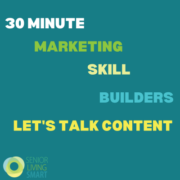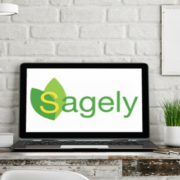What Is a Solo Ager & How Do You Market to Them?
You’ve likely been hearing the term “solo ager” more and more. This is yet another demographic you must keep in mind as you market your senior living communities, especially if your levels of care focus on active adult living and independent living.
But what is a solo ager, exactly? Do you need a completely new marketing playbook for them? This article aims to answer those and other relevant questions.
What is a solo ager?
Solo agers are adults in their mid-50s and older who are aging “solo” since they don’t have children or current life partners. Some solo agers might be widowed or divorced—or they never married in the first place. Others might not have any children—or the children they had are deceased. Whatever their circumstances, what solo agers have in common is navigating their senior years on their own.
A synonym for solo agers includes “kinless seniors.” (The New York Times published “Who Will Care for Kinless Seniors” in June 2023, which is worth the read.)
Here are some interesting stats about this demographic:
12% of adults over 50 are aging solo. [Source: AARP]
27% of American adults aged 60 and older are aging solo, and older adults in the U.S. are more likely to live alone than anywhere else in the world. [Source: Pew Research Center]
The percentage of one-person households more than tripled in the U.S. between 1940 and 2020, going from 7.7% to 27.6%. [Source: U.S. Census Bureau]
In 2019, nearly one million older Americans had no spouse, partner, children, or siblings (approximately 370,000 were women over 75). [Source: The New York Times]
Solo agers aren’t necessarily sad about going it alone
Don’t let any negative connotations with the word “solo” fool you. Many solo agers have chosen this path. For example, some older adults might end a long-term marriage later in life to pursue happiness elsewhere, like Al and Tipper Gore famously did. This is known as “gray divorce,” and it’s been on the rise.
And even if becoming a solo ager wasn’t intentional, that doesn’t mean solo agers are necessarily sad about their position (though some are). As AARP notes in a recent survey, even though solo agers might face challenges, most feel “optimistic about their quality of life as they age,” with only 12% of those surveyed saying they feel pessimistic.
Still, it’s also worth noting that the same AARP article revealed that solo agers haven’t planned for their future living arrangements, even though statistically 70% of people over 65 will need long-term care at some point.
This suggests an opportunity for senior living marketers. The question becomes how to effectively reach this demographic.
How is marketing to solo agers different from marketing to other demographics?
Senior living communities are used to interacting with adult children just as much as older adults. With solo agers, the concept of an adult child (or other family member) is no longer in play. This could make the sales process easier since you won’t have multiple influencers, just the solo ager. The challenge will be piquing the solo ager’s interest to begin with.
The AARP survey revealed that most solo agers haven’t given thought to what’s next: “Among those still living in their own home, the survey shows 95% have not made a reservation at a community for older adults, looked for a cheaper or easier place to live (82%), or modified their home to make it easier to live in as they age (78%).”
This suggests the solo ager sales cycle might be longer than for independent living, which is already long and requires at least 22 touch points.
Developing marketing campaigns for solo agers—starting with educating them on what senior living is and how they can finance it as a single person—is a smart first step communities can take now. You should also produce content about related issues that solo agers are researching and reading online. For example, many solo agers subscribe to AARP publications. Running ads or advertorials with AARP could be a way to begin planting the seed with solo agers that there’s a place for them in senior living.
- PRO TIP: A great time to engage solo agers is around the holidays, like Thanksgiving and Christmas. You could do a targeted campaign for solo agers in your area, inviting them to a festive event in your community. The fourth quarter is historically slow for senior living sales because potential residents want to spend one last holiday with their families. But most solo agers won’t have this objection. Your marketing and sales teams could create a compelling offer that entices solo agers to move in November or December.
Do you need a new marketing playbook for solo agers?
Good news! Your marketing playbook doesn’t need to change, but the messaging does. You’ll still want to use marketing automation and compelling content, just like you do for other demos. But you’ll need to begin with more education and help solo agers feel like there’s a true place for them in your community and that you’re not simply swapping the words “solo agers” into all of your existing messaging geared toward other personas, like older couples or people with adult children.
Instead, you must offer messaging that will resonate with this demo and reinforce their independence and desire for choice while empowering them to see the value in—and ultimately make the move to—senior living.
- Develop a solo ager persona. This is an entirely new persona, one that will evolve as everyone begins to better understand the solo ager’s specific wants and needs.
- Create educational content that will resonate with them. This persona needs educational content that demonstrates you understand who they are.
- Follow solo-aging trends. Because this persona is so new, no one has it figured out. We’re in unchartered territory. (The name “solo ager” might change, too.) Set up relevant Google Alerts on solo aging and any synonyms that develop. Follow brands that successfully cater to this demo and study their messaging. Experiment with different messaging, see what works, and fine-tune from there.
From a broader organizational perspective, senior living communities might need to rethink what senior living looks like for this demo. (This is true for Boomers, too.) These are incredibly independent personas. Apartments with shared walls won’t be as attractive as stand-alone homes. This shift could impact your existing campus—or plans for new construction. But it’s not an unheard-of idea. (This senior living community in Massachusetts offers spacious two-bedroom standalone cottages with garages on its campus—and all the typical amenities, like dining and housekeeping.)
Bottom line: Start focusing on solo agers NOW
This is a long-term play. Solo agers in their mid-60s won’t be signing leases with your assisted living or independent living community tomorrow—or next year. However, if you prime this persona’s pump now, especially through education and by demonstrating you understand their unique needs, your community will stand a better chance of engaging with them when they are ready.
If you need help with any of this, work with us. We’ve created a bunch of solo aging-specific content, including a guide designed specifically for solo agers, that our clients can customize and use to target this demo. Reach out to learn more.











